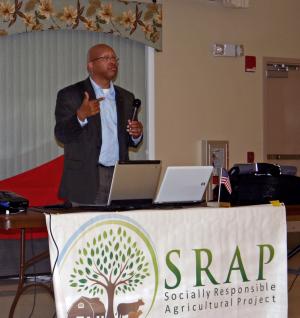Poultry plant opponents urged to fight for justice
Sacoby Wilson told residents who oppose a proposed chicken processing plant near Millsboro that if they want to be heard, they might have take an old-school approach.
Wilson, an assistant professor at the University of Maryland who holds a doctorate in environmental health, said environmental justice is a social movement, and that if concerns are not addressed and questions are not answered, sit-ins might be the solution.
“You cannot assume the government is going to do the job you're supposed to do,” he said. “It's your story. You have to use your own voice.”
|
Poultry industry in Delaware
Source: Sacoby Wilson and U.S. Department of Agriculture's Census of Agriculture 2012 |
||||
The grassroots group Protecting Our Indian River, which recently appealed a special use permit to convert the former Vlasic pickle plant near Millsboro into a chicken processing plant, and the Socially Responsible Agricultural Project invited Wilson to Millsboro Nov. 5 to outline what environmental justice means, what locals can do and how residents can ensure that a health-impact study is conducted before the plant is up and running.
Protecting Our Indian River currently is awaiting Sussex County Superior Court Judge Richard Stokes' ruling on the group's appeal to overturn a special use permit granted by the county's board of adjustment. The plant was purchased in October by Allen Harim Foods LLC, which has proposed a $100 million chicken plant that would bring in 200,000 to 2 million chickens a week and create 700 jobs.
The appeal argues that the board of adjustment failed to consult input from relevant agencies such as the Center for the Inland Bays, the Environmental Protection Agency and the Delaware Division of Public Health.
Jay Meyer, of Protecting Our Indian River, said the group has been fighting the proposed plant with facts, but their questions and concerns about the site of the plant are ignored or rejected by state officials. In addition, some state agencies, specifically the Department of Natural Resources and Environmental Control, have not been doing due diligence, he said.
Meyer said residents of Possum Point, a neighborhood near the proposed chicken plant, found out only in 2013 that DNREC was notified by Vlasic in 1991 that a plume of contamination was migrating from the plant site to the development, but did nothing about it.
“We tried to get information from the state of Delaware through the Freedom of Information Act and zero, nothing,” Meyer said. “We put a request in back in June, and we still haven't heard anything. How can we do anything when the state of Delaware, the representatives of the state of Delaware [and] DNREC just want to ignore everybody?”
Wilson said when agencies are ignoring the public, sit-ins might elicit a response.
“Do sit-ins. This is old-school stuff, folks,” Wilson said. “Agitate with data. Agitate with science. Agitate with facts.”
Wilson, who has extensively studied hog farms in North Carolina, said that agricultural pollution often plagues communities that are targeted because of racial and ethnic disparities, a lack of economic resources and a lack of access to infrastructure.
But whatever the reason for potential pollution threatening a community, Wilson said it's up to the local residents to play a role in environmental decisions by making their voices heard.
“It's your job as an engaged citizen … [to make] sure you're always present and always educated,” he said. He recommended brushing up on state regulations and laws, like the Clean Water Act, as well as familiarizing with federal organizations like the EPA, Department of Justice and the U.S. Department of Housing and Urban Development, which act as parent organizations to state agencies.
“Instead of going to the child, which is the state, take it to the parent, which is the federal government,” he said.
He added that partnerships of state, federal, environmental, health and grassroots organizations should result in collaborative problem-solving. He offered to be the expert to connect the dots for the concerned Millsboro residents, who also voiced concerns that no health-impact study has been scheduled for the plant.
“This social movement is really a marriage between the environmental movement and the civil rights movement,” he said. “When we think about environmental justice, it's really about fair treatment and meaningful involvement of all people across race, class, income, culture. Everyone should be engaged with the environmental decision-making process.”




















































